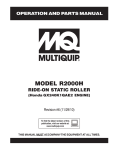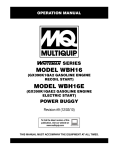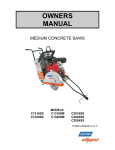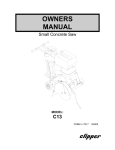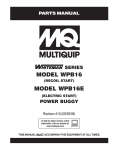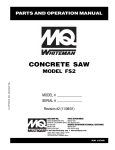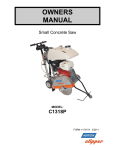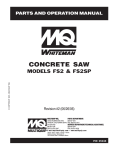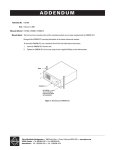Download Clipper C13SPM Specifications
Transcript
OWNERS MANUAL MEDIUM CONCRETE SAWS MODELS: C13SPM C13SPE C20SPE FORM C20SP 3-2005 WARRANTY Norton warrants all products manufactured by it against defects in workmanship or materials for a period of one (1) year from the date of shipment to the customer. The responsibility of Norton under this warranty is limited to replacement or repair of defective parts at Norton's Gainesville, Georgia factory, or at a point designated by it, of such part as shall appear to us upon inspection at such point, to have been defective in material or workmanship, with expense for transportation borne by the customer. In no event shall Norton be liable for consequential or incidental damages arising out of the failure of any product to operate properly. Integral units such as gasoline engines, electric motors, batteries, tires, transmissions, etc., are excluded from this warranty and are subject to the prime manufacturer's warranty. This warranty is in lieu of all other warranties, expressed or implied, and all such other warranties are hereby disclaimed. Important: Before placing equipment in operation, record the following information. MODEL:_________ SERIAL NO.___________ PURCHASE FROM: _____________________ ADDRESS: ____________________________ CITY_______ STATE ______ ZIP ________ TELEPHONE NO. ______________________ Before using this equipment, make sure that person using it read and understand the instructions in this owners manual. Table Of Contents 2 CONTENTS PAGE I. Preparation A. Safety Precautions B. Assembly C. Engine Specifications D. Pointer Alignment 4-6 7 8 9 II. Operation A. Blade Installation B. Starting The Engine C. Water Supply D. Operating The Saw E. Cutting Technique F. Lead-Off Adjustment 9 10 10-11 11-12 12-13 13 III. Maintenance A. Engine B. Bearings C. V-Belts D. Depth Control E. Transmission F. Self-Propelling Unit G. Changing The Blade Cutting Side 14-15 16 17 18 18 19 19-20 IV. Parts List Section A. Ordering Information Assembly Drawing B. Service Parts C. Engine Warrany 21 22-2425-27 28 Read Owners Manual Before Use Safety Alert Symbol: Information Following This Symbol Is Very Important. 3 I. PREPARATION A. Safety Precautions Important! The following safety precautions must always be observed. Hazard Symbols Fuel (gasoline) is extremely flammable and its vapors can explode if ignited. Store gasoline only in approved containers, in well ventilated , unoccupied areas approved, and away from sparks or flames. Don not fill the saw fuel tank while the engine is hot or running. Do not start the engine near spilled fuel. Never use the fuel as a cleaning agent Engine components can get extremely hot from operation. To prevent burns, do not touch the engine are or related parts while the engine is running or immediately after it is turned off. Never operate the engine with any heat shields or guards removed. Keep all guard in place when operating any piece of equipment Keep hands, feet, hair, and clothing away from all rotating parts Lethal Exhaust Gas use only in well ventilated areas. Engine exhaust gases contain poisonous carbon monoxide which is orderless, colorless, and can cause death if inhaled. Avoid inhaling exhaust fumes, and never run the engine in a closed building or confined area Never tamper with the governor components of settings to increase the maximum speed. Severe personal injury and damage to the engine or equipment or equipment can result if operated at speed above maximum. Always obey the maximum speed rating of blade. DO NOT LIFT THE SAW BY THE HANDLE BARS 4 Dust and Silica Warning Grinding/cutting/drilling of masonry, concrete, metal and other materials can generate dust, mists and fumes containing chemicals known to cause serious or fatal injury or illness, such as respiratory disease, cancer, birth defects or other reproductive harm. If you are unfamiliar with the risks associated with the particular process and/or material being cut or the composition of the tool being used, review the material safety data sheet and/or consult your employer, the material manufacturer/supplier, governmental agencies such as OSHA and NIOSH and other sources on hazardous materials and make certain to comply with all product warnings and instructions for the safe and effective use of the material being cut. California and some other authorities, for instance, have published lists of substances known to cause cancer, reproductive toxicity, or other harmful effects. Control dust, mist and fumes at the source where possible. In this regard use good work practices and follow the recommendations of the manufacturer/supplier, OSHA/NIOSH, and occupational and trade associations. Water should be used for dust suppression when wet cutting is feasible. When the hazards from inhalation of dust, mists and fumes cannot be eliminated through engineering controls such as either vacuum and/or water mist, the operator and any bystanders should always wear a respirator approved by NIOSH/MSHA for the material being cut. Use Approved: Eye Protection Hearing Protection Respiratory Protection 5 Head Protection 1. Before mounting any blade on the saw, the blade should be inspected for any damage which might have occurred during shipment, handling or previous use. 2. The blade collars and arbors should be cleaned and examined for damage before mounting the blade. 3. The blade must be properly fitted over the arbor with the drive pin on the outside collar projecting through the drive pin hole on the blade and inside collar. 4. The blade shaft nut, which is a left hand thread nut, must be tightened securely against the outside blade shaft collar. 5. The blade must be operated within the specified maximum operating speed listed on the blade. 6. Turn water control valve to full to provide adequate coolant (5 to 8 gallons per minute) for diamond blades and wet cutting abrasive blades. Insufficient coolant could result in severe blade breakage or diamond segment separation. 7. The blade guard must be in place with the nose guard down and locked when the saw is running. 8. The operator should wear safety glasses and any other appropriate safety equipment. 9. When starting the saw, the operator should stand away and to the side of the blade. 10. If for any reason the saw should stall in the cut, raise the blade out of the cut. Check the outside blade shaft collar and nut for tightness. Inspect the blade for damage before restarting the saw. User caution when resuming a cut. Be certain that the blade is in alignment with the previous cut. 11. During cutting operations, do not exert excess side pressure on the handles as a method of steering. Do not force the blade into the cut by lowering the blade too fast or by pushing the saw too fast. You Are Responsible For Your Safety!!! 6 I. PREPARATION B. Assembly The self-propelled concrete saws are shipped completely assembled and ready for use except for diamond blade, gasoline, oil, and handle bar. Inspect the saw for shipping damage. If any damage is found, contact the shipper immediately and file a freight claim. The Norton Company is not responsible for any freight-related damages. Remove the saw from the pallet. Reverse the position of the handlebars so that the handle bar sticks out towards the operator. Adjust the handlebars to the desired height. Attach the handlebars to the saw with the supplied hardware. For electric start models fill and check the electrolyte level and charge the battery. Read and understand the remaining sections of this Owners Manual. NOTE: Do not install the blade until it is time to use the saw. ANSI regulations prohibit the transportation of any concrete saw with the blade installed. 7 C. C13SP/C13SPE/C20SPE Concrete Saw Specifications Dimensions/Weight Length (Transport) Width Height Weights Engine Engine Mfg. Model Spec No. Engine Type Horse Power Max Torque Cooling System Oil Capacity Fuel Capacity Fuel Type Low Oil Sensor Air Filtration Characteristics Max Blade Depth of Cut 24” (406 mm) 20” (356 mm) 16” (305 mm) Arbor Bore Blade Shaft Locking Device Blade Shaft Speed Depth Control Depth Lock Depth Gauge Number Of V-Belts Blade Guard Type Right or Left Side Cutting Lifting Bale Handle Bars Water Tank Water Tank Capacity Water Hose Connector Recessed Rear Wheels C13SPM C13SPE C20SPE 56 inch (1142 mm) 56 inch (1142 mm) 56 inch (1142 mm) 26 inch (600 mm) 26 inch (600 mm) 26 inch (600 mm) 40 inch (1016 mm) 40 inch (1016 mm) 40 inch (1016 mm) 385 lbs (175 kg) 405 lbs (175 kg) 428 lbs (195 kg) Honda Honda Honda GX390 GX390 GX620 GX390K1QXC9 GX390K1QAE2 GX620K1QXW2 Single Cylinder 4 Cycle 13 hp (9.5kW) @ 3,600 rpm 19.5 ft-lbs (26.5 Nm, 2.7 kgf-m) @ 2,500 rpm Air Single Cylinder 4 Cycle 13 hp (9.5kW) @ 3,600 rpm 19.5 ft-lbs (26.5 Nm, 2.7 kgf-m) @ 2,500 rpm Air 1.1 liter (1.16 US qt) 6.5 liter (1.79 US gal) Unleaded Gasoline (86 pump octane) Yes 1.1 liter (1.16 US qt) 6.5 liter (1.79 US gal) Unleaded Gasoline (86 pump octane) Yes Four Stage Cyclone 20” (356 mm) Two Stage Honda Two Cylinders 4 Cycle 20 hp (14.9kW) @ 3,600 rpm 32.5 ft-lbs (44.13 Nm, 4.50 kgf-m) @ 2,500 rpm Air 1.8 liter (1.90 US qt) 9 liter (2.48 us gal) Unleaded Gasoline (86 pump octane) Yes Four Stage Honda 20” (356 mm) 24” (406 mm) -NA- -NA- 9-1/2 inch (241 mm) 7-1/2 inch (191 mm) 7-1/2 inch (191 mm) 7-1/2 inch (191 mm) 5.50” (140 mm) 5.50” (140 mm) 5.50” (140 mm) 1 inch (25.4 mm) Machined Into Flats Of Tight Collar 2600 rpm, Hand Wheel With Screw Feed Standard Customer Installed Accessory 4 Hinged, All Steel Construction Yes Built In Adjustable, Stays Level At All Times Standard 5.28 US Gallons (20 liter) Standard Garden Hose With Flow Control Valve Standard 8 II. OPERATION Read and understand this manual before running or using the machine! A. Installing the Blade 1. Disconnect the spark plug and then insert the Blade Shaft Locking Pin into the Blade Shaft Locking hole. 2. Remove the blade shaft nut, (Turn clockwise) , and remove the outside collar. 3. Clean off any foreign particles on the clamping surfaces of both collars and on the mounting surface of the blade. 4. Place the blade on the blade shaft, lining up the drive pin hole in the blade with the drive pinhole in the inside collar. Use only Clipper Diamond Blades. This machine was not designed for the use with abrasive blades. 5. Slide the outside blade shaft collar onto the blade shaft . The drive pin on the outside collar must project through the drive pin hole in the blade and into the inside collar. 6. Tighten the blade shaft nut (counter-clockwise) securely against the outside collar and remove the Blade Shaft Locking Pin. 7. Reconnect the spark plug. Blades Use Only Clipper Diamond Blades 9 B. Engine Prior to attempting to operate the engine, read the information contained in the engine owner's manual. An engine owners manual is supplied with every gasoline powered concrete saw. 1. Check Oil: Add oil if low. Refer to the engine owner's manual for the recommended SAE viscosity grades. Capacity of oil is 1.1 liters (1.16 US qt) 2. Check Fuel: Fill if low. Use only unleaded gasoline with a pump sticker octane rating of 86 or higher is recommended. Never use an oil and gasoline mixture! 3. Air Cleaner: Never run the engine without the air cleaner! Rapid engine wear will result from contaminants being drawn through the carburetor and into the engine. 4. Engine Starting: Refer to the engine owner's manual for proper engine starting procedure. 5. Engine Speed: Always run the engine and the proper speed for the blade being used. Never run the blade at a higher speed that it is rated for. See the Blade Speed chart located on the machine’s console or located in the manual under the heading “Operating the Saw” C. Water Supply Pressurized source: Turn the water control to full "ON" when using wet cutting blades. The required flow rate is 4-6 gallons per minute. Water Tank on saw: This supply is designed for use with dry blades to keep the dust levels down. The tank will not supply the proper water flow rates when used with wet cut only blades. Do not drink the water from this tank. Fill the tank with water only. Close the water tank valve. Attach the saws water supply hose to the tank outlet. Fill the tank with water. The capacity of the tank is 5 US Gallons. When you are ready to cut, adjust the water supply rate until a fine mist or a slow trickle is made. The use of water greatly decreases the amount of dust produced during the cutting process, aids in the cooling of the blade, and provides additional stability. 10 • • Use Only Water In The Water Tank Do Not Drink From The Tank D. Operating The Saw 1. For the engine starting instructions see the Engine manual and follow the instructions located in section A. Installing the Blade of the II. Operation heading for Blade installation instructions. 2. Check the Engine Oil level. 3. Disengage the Self-propelling unit by moving the Transmission Engage/Disengage lever fully up and place the Speed Control in the neutral position. 4. Raise the saw to the full upright position. Do not let the blade come in contact with the ground. 5. Maneuver the saw to the desired starting point. 6. If wet cutting connect the water supply to the saw. 7. Follow the instructions for starting the engine found in the Engine manual. 8. If wet cutting turn on the water supply at the source and then open the water valves on the saw. Make sure that there is a minimum of two gallons per minute of water flow!! 9. Be sure that the engine is running at full throttle!!! Check Engine Speed on the Tachometer to that listed on the Blade Speed Chart located on the Console is correct for the diameter of Blade being used. Blade Eng RPM Eng Pulley 16 20 24 3600 3600 3000 2.65 2.65 2.65 B/S RPM 2600 2600 2200 B/S Pulley 3.65 3.65 3.65 10. Slowly lower the blade by rotating the hand wheel counter-clockwise until the desired depth of cut is reached. Use a reasonable rate of feed. Do not force the blade in to the cut!! 11 11. For Self-propelled models move the Transmission Engage/Disengage lever by fully to the Engage position and \ then slowly push the Speed Control forward until the desired speed is reached. If the engine begins to stall or the saw raises out of the cut slow the forward speed down!! The further the lever is pushed the fast the saw will move. 12. When the end of the cut is reached, slowly raise the blade out of the cut by rotating the Hand Wheel Clockwise until the blade is at least one (1) inch above the ground. 13. To use reverse, move the saw move the Speed Control lever to the rear of the saw. Only move the saw in reverse with the blade in the raise position. Always place the speed control back in the neutral position after moving the saw. 14. When moving the saw to a new location be sure that the blade is not touching the ground and always pay close attention to where you are moving and where the blade is at all times. 15. To disengage the transmission, place the Speed Control in the Neutral position and then slide the Transmission Engage/Disengage lever by fully to the “Disengage” position. Caution: Do Not Engage Or Disengage The Transmission While The Machine Is In The Forward Or Reverse Positions! E. Cutting Technique Lower the blade into the concrete to the required depth by turning the hand wheel counter-clockwise. Ease the handle slowly forward . Retard the forward pressure if the saw begins to stall. Note: For deeper cuts (4 inches or more), several cuts should be made in incremental steps of 1-1/2 to 2 inches until the desired depth of cut is reached. Push the saw steadily forward using the front pointer as a guide. Exert enough forward pressure so that the engine begins to labor, but does not slow down. If the saw begins to stall, retard the forward movement until full rpm is restored to the blade. If the saw stalls, raise the blade out of the cut before restarting. Avoid excessive side pressure or twisting of the blade in the cut. 12 Additional Guide Lines For Sawing: • Understand and follow all of the instruction in this owners manual. • If wet cutting, turn on the water supply so that there is a minimum of two gallons per minute of water flow!! • In critically hard aggregate more than a single pass may be needed to cut the desired depth. • Only move the Engage/Disengage lever while the transmission speed control is in the neutral position. • Move the transmission speed control slowly. • If the saw stalls in the cut, immediately stop the forward speed and raise the blade out of the cut. If this is not done the belts can fail or the blade may be damaged. • Go slowly with a new blade until it opens up, that is, until the diamonds can be seen and felt. • If the saw leads off excessively check the contact between the drive rollers and the rear wheels. Small steering corrections may be made by applying slight pressure to the right or left side of the handle bar. The drive rollers will need to be cleaned from time to time. F. Lead-Off Adjustment If the saw tends to lead off (cut to one side), it may be steered by applying slight pressure to the left or right hand handles. 13 A. Engine Follow the below schedule for engine maintenance. NOTE: Check the Honda Engine manual that came with the engine for any changes to the maintenance schedule. If the charts have any differences, follow the chart in the Honda Engine Manual. The Norton Company does not warranty the engine. If any warranty or service of the engine is required contact your nearest Honda service center, or from the Internet: http://www.honda-engines.com/home.htm Honda Power Equipment Group 4900 Marconi Dr. Alpharetta, GA 30005-8847 Tel: (800) 426-7701 | Fax: (678) 339-2670 Honda engine (refer to owner's manual for complete maintenance.) Check the engine oil level before each use when the engine is cool and the engine is level. Add oil if the level is low. The oil level should be within the operating range (see the engine owner’s manual for details). Only use a high-detergent, premium quality motor oil certified to meet or exceed U.S. automobile manufacturer’s requirements for Service Classification SG, SF/CC, CD. Motor oils will show the classification on the container. A SAE viscosity of 10W-30 is recommend by Honda for general, all temperature use. Please consult the below chart or contact your local Honda service center for the proper viscosity for your temperature range. 14 Always refer to the engine manual for more detailed information on checking the oil, changing oil, and oil capacity, air filter changes, and fuel type to use. Use only Honda air filters. Do not clean the air filter with gasoline or other flammable solvents. A fire or explosion could result. To clean, follow the instructions found in the Honda engine manual. Dry Cutting Engine Maintenance 9 When operating the engine in dry cutting or dusty environments the following is required: 9 Engine oil changed more often. 9 Every 50 hours (or more often if conditions require) clean all of the engine cooling fins. 9 Every 25 hours (or more often if conditions require) clean the engine precleaner. 9 Every 100 hours (or more often if conditions require) replace the air filter. If the engine is equipped with a reusable air cleaner, clean and re-oil it. 9 Check and clean the air filter after each use. Replace as needed. 15 B. Bearings Re lubrication type bearings must be relubricated daily to assure long life. The grease used should conform to the NLGI grade two consistency and be free of any chemical impurities such as free acid or free alkali, dust rust, metal particles or abrasives. For best results, bearings should be relubricated while in operation. Note: Due caution for personal safety must be observed when servicing rotating equipment. The grease should be pumped in slowly until a slight bead forms around the seals. This bead, in addition to acting as an indicator of adequate relubrication, provides additional protection against the entry of foreign matter. If necessary to relubricate while the bearing is idle refer to relubrication table for maximum grease capacity for the various size bearings. Shaft Size Maximum Grease Capacity of Bearing Chamber in Ounces 1/8 3/8 5/8 1/2"' to 3/4" 7/8" to 1-3/16" 1-1/4" to 1-1/2" 16 III. MAINTENANCE C. V-Belts Warning: Never make adjustments to belts or pulleys while engine is running! 1. The best tension for a belt drive is the lowest tension at which the belts will not slip under full load. 2. Simply take up the drive until the belts are snug in the grooves. Run the drive for about 15 minutes to "seat" the belts. Then impose the peak load. If the belts slip tighten them until they no longer slip at peak load. 3. Remember too much tension shortens belt and FIGURE 1 bearing life! FIGURE 2 4. Check the belt tension frequently during the first day of operation. Check the belt tension periodically thereafter and make any necessary adjustments. 5. The two most common causes of misalignment are shown in the drawing. a). The engine drive shaft and the blade shaft are not parallel. FIGURE ONE b). The pulleys are not located properly on the shafts. FIGURE TWO 6. To check alignment , all you need is a steel straight edge . 7. Line up the straight edge along the outside face of both pulleys as shown in the drawing. 8. Misalignment will show up as a gap between the pulley face and the straight edge. 9. Make sure that the width of the outside land is equal on both pulleys. 17 III. MAINTENANCE D. Depth Control The depth control (raising screw) consists of a threaded rod which feeds into a brass nut . In order to keep the two parts working smoothly it is necessary to keep the rod free from dirt and sludge as much as possible. Cleaning the threaded rod with a rag after each use will prevent sludge from collecting in the tube assembly and protect the threads. It is a good practice to keep the raising screw threads lubricated, as the slurry generated during cutting will cause premature thread wear. The bearing used to support the raising screw should be checked after each use to make sure it is turning freely and lubricated. If the bearing requires re lubrication a lithium base grease is recommended. E. Transmission Eaton Model 6 Hydrostatic Transmission: 1. Accurate fluid level readings can only be made when the fluid is cold. 2. If the natural color of the fluid has become black or milky, the transmission has over heated or water containment has occurred. Drain and replace the fluid, check the fan and accessory belts, clean the cooling fins, and also check for any fluid leakage. Do not pressure wash the transmission. 3. Use only the proper viscosity and type of fluid. At normal operating temperatures, the optimum viscosity range is between 80-180 SUS (16-40 CS) and it should never fall below 60 SUS (10 CS). 4. The fluid should be chemically stable, incorporating rust and oxidation inhibitors. Recommended Fluids For Eaton Model 6 Transmissions 1. Mobil Fluid 300 2. Texaco TL 2209 3. Dextron B (General Motors) 4. M2C-33F And M2B-41A (Ford Motor) 5. Hy-Tran (International Harvester) 6. 10W Straight Viscosity SE, CC, or CD Rated Engine Oil * 7. 20W Straight Viscosity SE, CC, or CD Rated Engine Oil 8. 30W Straight Viscosity SE, CC, or CD Rated Engine Oil * Factory Supplied Transmission Fluid 18 F. Self-Propelling Operations 1. Speed Control Lever: The operators right hand lever is the speed control lever. Pushing the lever slowly forward will increase the forward speed of the saw. Pulling it to the center will place the saw in neutral. Pulling the saw to the rear of the console (from the neutral) will increase the reverse speed. 2. Transmission Engage/Disengage Lever: Transmission Engage/Disengage lever has two (2) positions onto which it can be moved: Engaged position (Down) allows the transmission to operate the rear drive wheels by the means of rear wheel friction rollers, the Disengage position (Up) release the rear wheel friction rollers from the rear drive wheel (the saw can be “Free Wheeled” or moved when repositioning the saw or moving it without running the engine. NOTE: When parking the saw, it should always be left in the Engaged position , Speed Control Lever in the neutral position, the engine OFF, and perpendicular (right angle) to the grade (hill). 3. Drive Wheel Adjustment: Keep the chain clean and properly adjusted. To change the engagement pressure of the friction rollers, disengage the transmission and reposition loosen the fasteners that mount this lever to the transmission and readjust the friction rollers so that there is a 1/4” clearance (move the transmission platform up or down) between the friction rollers and the rear wheels. Retighten the mounting hardware. Clean the rear friction rollers wheels, slurry will build up on the friction rollers and cause the friction rollers to slip. Normally spraying the friction rollers and rear wheels with water will clean out the slurry. G. Changing The Blade Cutting Slide The saws can be used for either left or right hand cutting. Tight and loose collars fit both the left and right ends of the blade shaft. To Change Blade Guard Side Follow The Below Directions: NOTE: The following directions are based on the blade guard being mounted on the operators Right hand saw. The blade shaft nut on the operators Right hand side is a Left handed threaded and the blade shaft nut on the operators Left hand side is a Right handed thread. Reverse the following directions to move the blade guard from the operators Left hand side to the Right. 1. Disconnect number one spark plug on the engine. 19 2. Remove the operators Right hand side blade nut (NOTE: Left hand thread) and Loose Collar. 2. Remove the blade from the saw if installed. 3. Remove the Blade Guard buy loosing the Blade Guard Locking Screw located on the front side of the Blade Guard and remove the Blade Pivot Bolt, Washer, and Nut from the rear of the Blade Guard. 4. Remove the Blade Shaft Guard from the operators left hand side of the machine. 5. Swap the sides of the Blade Guard Locking Screw (now should be on the Right side of the guard). 6. Reroute the Water Hose around to the Left side of the machine. NOTE: Do not let the Water Hose come in contact with the Muffler or the Engine. 7. Attach the Blade Guard to the operator’s Left hand side of the machine. NOTE: The head of the Blade Pivot Bolt goes to the inside of the frame. The Nut goes to the outside of the blade guard. Tight down the Blade Guard Locking Screw. 8. Remove the Operator’s Left hand side Blade Nut and Loose Collar. 9. Place the Blade on the Operator’s Left hand side of the Blade Shaft. 10. Attach the Loose Collar and Operators Left hand side Blade Shaft Nut to the machine. Properly tighten the Blade Shaft Nut. 11. Attach the Operator’s Right hand side Loose Collar and Blade Shaft Nut. 12. Attach the Blade Shaft Guard to the Operator’s Right hand side of the machine. 13. Remove the Pointer and reattach it to the Operators Left hand side of the machine. NOTE: Reverse the orientation of the Pointer. 14. Retighten all Screws. 15. Reattach the Spark Plug Wire. 20 IV. PARTS LIST SECTION A. Ordering Information 1. List model number and serial number of machine. 2. List part number and serial number of part not the item number. 3. Wherever alternate parts are shown due to product improvement, inspect the part you have and provide additional description as necessary. 4. Specify mode of shipping desired, such as, parcel post, truck, U.P.S., best way, etc. For the nearest Clipper distributor call 1-800-554-8003 Common Replacement Parts Description Belts V-belts (set of 4) Blade Shaft Nut ¾-16 Left Hand Thread (Operators Right Side Of Saw) Blade Shaft Nut ¾-16 Right Hand Thread (Operators Left Side Of Saw) Collar Tight (Operators Right Side) Collar Tight (Operators Left Side) Collar Loose Assembly (With Pin) Drive Pin ∅3/8 x 1 Bearing Blade Shaft (1) Front Wheel Complete (1) Rear Wheel (1) Wrench 1-1/2” Wrench 32mm Wrench 17mm Part Number 227156 227191 227159 227190 227247 227154 105377 82910 72279 NOTE: All Parts Are Sold As Individual (each) Unless Noted Otherwise Blades Use Only Clipper Diamond Blades. Contact your local Clipper Distributor or Clipper at 1-800-554-8003 for the best blade for the application. 21 B: Service Parts C13SP & C20SP Common C13SP C20SPE Item 1 2 3 4 5 6 7 8 9 10 11 12 13 14 15 16 17 18 19 20 21 22 23 24 25 26 27 28 29 30 31 32 33 34 35 36 37 38 39 40 41 42 43 44 45 46 47 Model All All All All All All All All All All All All All All All All All All All All All All All All All All All All All All All All All All All All All All All All All All All All All All All All All Part No 83925 83926 83927 83928 83929 83930 83931 83932 83933 72097 83934 83935 83936 84045 84032 83357 82794 72357 227116 107859 83218 72286 82998 83937 83938 83939 84033 83367 84034 83940 82786 84036 84046 84047 84035 83941 84066 72067 83942 76670 76357 76465 84048 83943 84049 83944 84050 75061 83947 UPC # 70184674388 70184650630 70184682454 70184648715 70184681299 70184681064 70184681040 70184655787 70184655903 70184681046 70184665218 Description Upper Frame Board plate Upper closing plate Under closing plate Pivoting frame Belt guard Transport handle Handle support Depth indicator rubber handle Lifting hook Water tank support Guide-a-cut Wheel guide-a-cut Pointer Water tank Water tank stopper Tap Fit 1/2MPT X3/4 F Garden Hose SW Valve Ball 1/2" Brass Water connector Water connector Y Nozzle (set of 2) Blade guard 16" Blade guard 20" Blade guard 24" Splash guard Fixing screw Cover for collar Rocking frame Front wheel Hiding part Back wheel Wear ring Bearing Tube raising nut Stop ring Stop ring Raising screw Bearing + screws Handwheel Handwheel handle Fixing ring Handle stay level bar Fixing ring Handle stay level shaft Wear ring Bearing Screws 48 49 50 51 52 53 54 55 56 57 58 59 60 61 62 63 64 65 66 67 68 69 70 71 72 73 74 75 76 77 78 79 80 81 82 83 84 85 86 87 88 89 90 91 All All All All All All All All All All All All All All All All All All All All All All All All All All All All All All All All All All 16” 20” 24” All All All All All All All All All C13SP M C13SPE C20SP All 83945 83946 72279 70807 82910 83314 83948 227159 83949 72474 83950 83951 83952 227190 227247 83361 83359 83953 83954 83955 83956 83957 84037 73860 83958 84038 84039 76670 83959 84040 84041 83960 84053 84051 82808 84052 72345 84042 84043 83961 83962 83963 83964 83965 83967 83968 83370 84044 82811 83966 70184655806 70184655735 70184681049 70184681050 70184673904 70184681598 70184674352 70184674082 70184681056 70184681055 70184655903 Depth lock wheel Shaft Wrench 17mm Wrench 19mm Wrench 32mm Wrench 1 1/2" Blade shaft complete Inside collar Blade shaft alone Bearing & screws Pulley & key (16" blade) Pulley & key (20" blade) Pulley & key (24" blade) Inside collar Outside collar Nut RH Thread Nut LH Thread Belt tensioner cpl. Tension disc Tension spring Tension arm Motor pulley Pulley transmission Hydrostatic transmission Bracket speed adjustment Fixing bracket Friction disc Bearing Flange Kit Depth Control Advance shaft Bevel gear Bevel gear Hydrostatic trans. Support Chain Belt Belts XPZ 860 LW (set of 4) Belts XPZ 900 LW (set of 4) Belts XPZ 910 LW (set of 4) Spring Advance bar Speed lever Lever Throttle Throttle Battery support Battery protection part Motor support Motor GX390 Manual start Motor GX390 Electric start Motor GX620 Electric start Battery YBP16-B 92 93 All All 84067 73862 Waste oil hose Fan NOTES Norton Construction Products PO Box 2898 Gainesville, GA 30503 Phone: 800-554-8003 or 770-967-3954 (8:00 A.M. to 7:00 P.M. Eastern Time) Fax: 800-443-1092 or 770-967-7287






























